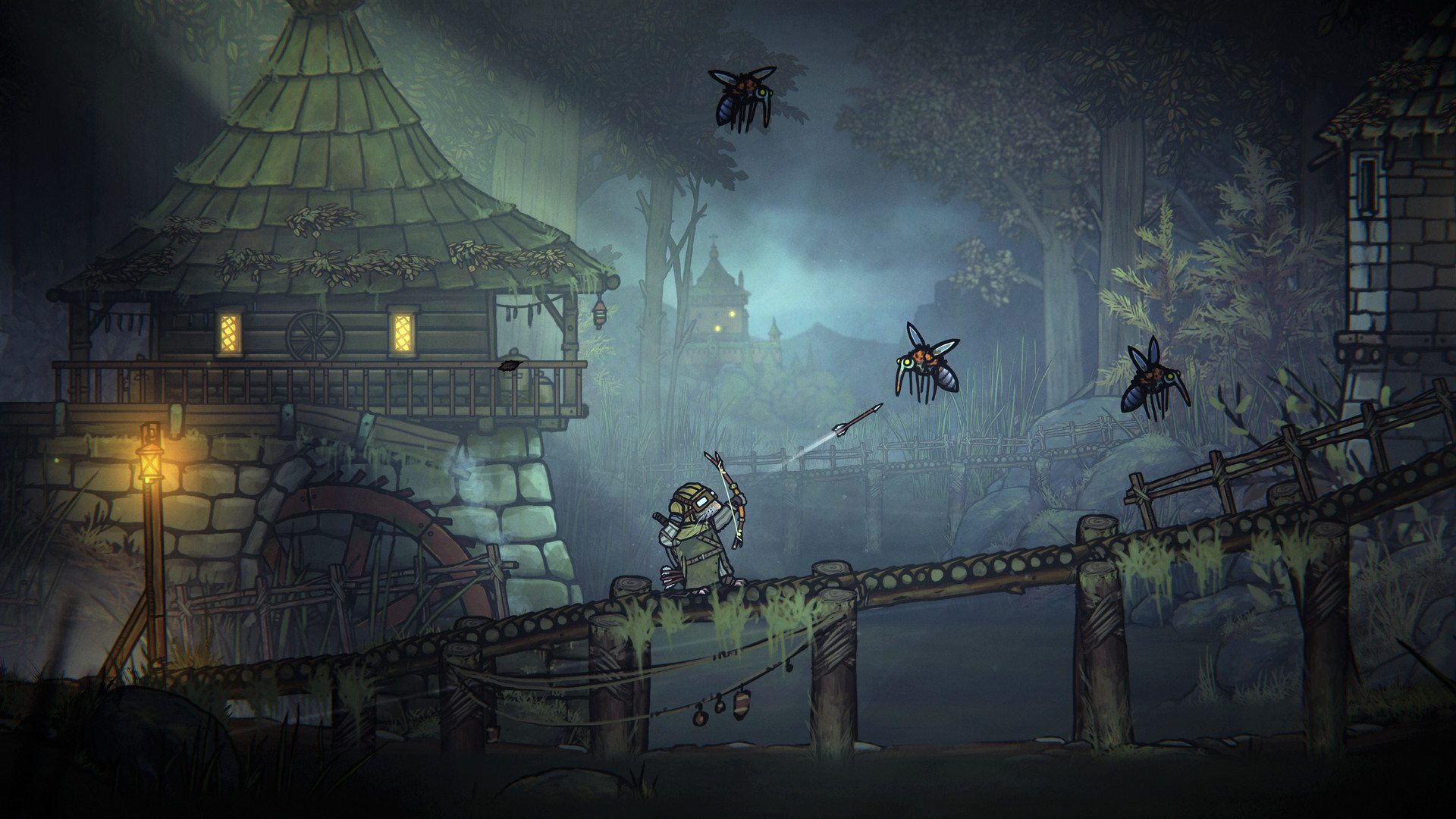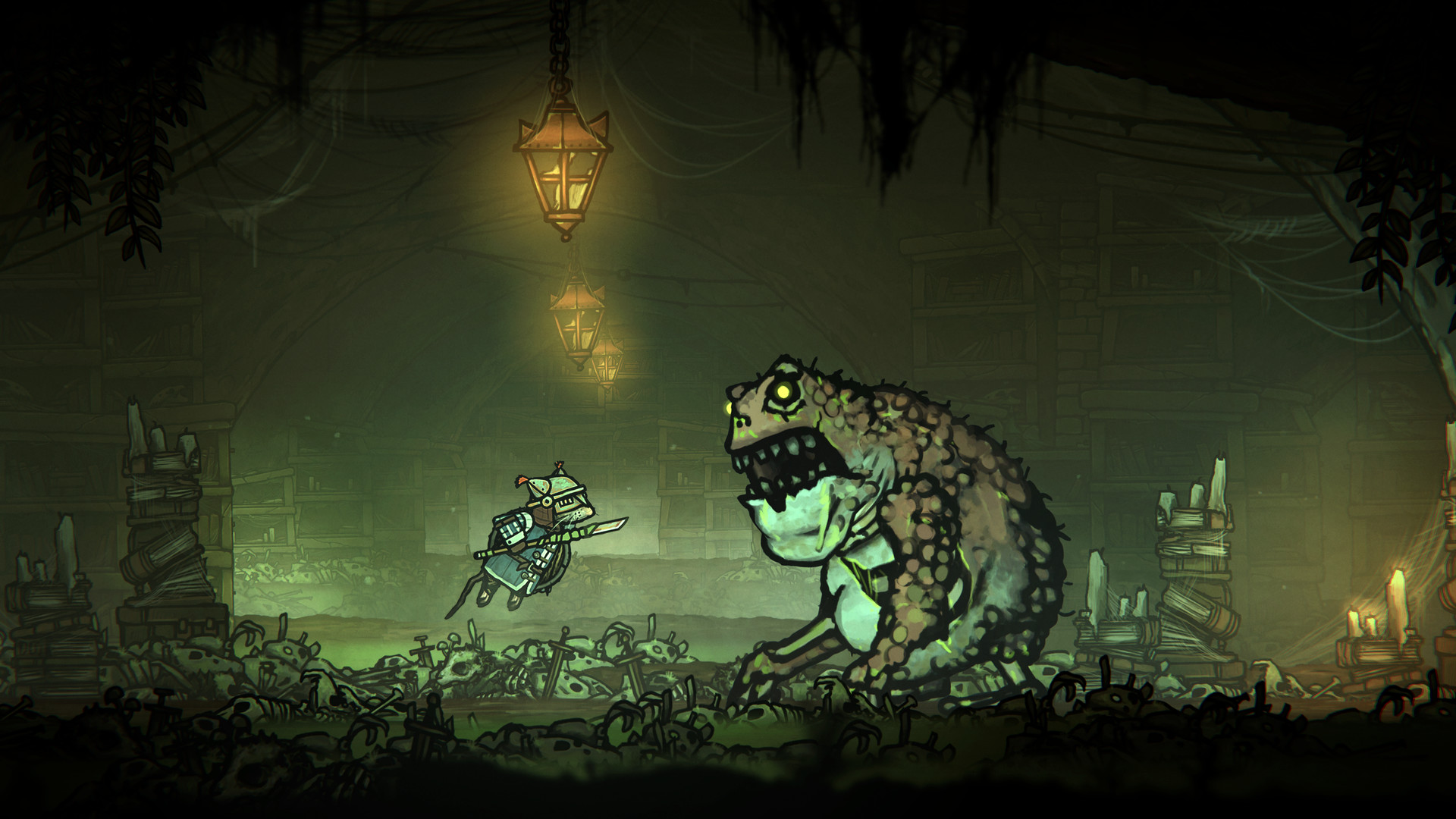
It’s not every day that you come across a game that juxtaposes a whimsical story-book art style full of forest animals with a brutal weapon-based combat system. It’s also equally uncommon for such ideas to blend together in a seamless way that doesn’t feel forced or inorganic. Tails of Iron strives to be a game that accomplishes all of this with its light emphasis on RPG mechanics and a rather bleak, somber overall tone. While it does seem to check a lot of the boxes that a game like this should, I still never quite felt all of its pieces click into place in a consistently satisfying way.
Tails of Iron starts off at the peak of a long-fought rivalry between two kingdoms; the frogs and the rats. After a sustained period of tranquility, the rat kingdom once again finds itself in peril as the aging king can no longer protect it. Of course, the heir to the throne is his son, who you control throughout the treacherous journey of rescuing and re-establishing the rat kingdom to its former glory. This won’t come easy though, as legions of warty frogs revel at the chance to stand in your way. The story is about as cookie-cutter as it gets for RPGs, and you shouldn’t go into it expecting any interesting twists outside of the archetypal characters that you normally see in games like this replaced with rats and frogs. It does set itself up well despite unabashedly refusing to deviate from the formula in almost any meaningful way. How much it’s predictability might bother you will largely depend on how much the minutiae of the story of a game like this matters to you. To its credit you do get a pretty good sense of the tone of the game from its highly detailed world. Everywhere you look there is a visual feast. Ruins and macabre pepper every area and the nice variety of color pallets and multitude of scrolling layers go a long way to establishing the vibe – even if the story itself doesn’t.
"While Tails of Iron does seem to check a lot of the boxes that a game like this should, I still never quite felt all of its pieces click into place in a consistently satisfying way."
Tails of Iron’s gameplay is a similarly mixed bag. It checks a lot of the side-scrolling action-RPG boxes well enough with a wide variety of weapons and shields that make you balance out their effectiveness with their weight, a handful of enemy types that require different approaches to take down, and the occasional bit of backtracking and side quests that can sometimes make the game feel like something bigger than it actually is. Depending on what you’re looking for from this sort of game, it could be right up your alley if you don’t want to deal with the complexities of truly deep combat or be overwhelmed with the open-ended nature of a really expansive world. Afterall, there is nothing wrong with a simplistic take on a genre that normally sees more complex games come out of it. And to its credit, there is a bit more meat on the bone than first meets the eye with food recipes that can be learned and a fair amount of weapons and armor that can be collected. But Tails of Iron’s primary problem is not it’s watered-down nature; it’s that it doesn’t make any of its main mechanics fun or satisfying enough to weather the storm of monotony that inevitably rolls in once you notice it’s small handful of ideas starting to repeat themselves.
The combat of Tails of Iron is presented as the main course, and does have a few functional albeit boiler plate ideas that keep it from falling into complete mediocrity. Sneaking a few hits in between using your shield to block, dodging when red indicators are shown, and parrying when yellow indicators are shown is a delicate dance that can be fun when it’s all happening at once and you’re in the zone. Certain enemies might hang back and fire arrows at you while you’re dealing with others in close-quarters, and depending on the situation you could justify going after either one first. When bigger enemies come in however, they tend to have more distinct patterns that, in turn, force you to fight them in very specific ways that rarely allow for much experimentation.
You’ll learn this quickly, as fighting more than a few basic enemies at a time in the “wrong” way can quickly result in a chain reaction of getting bashed by all of them and killed before you even know what hit you. Parrying requires two button presses, both of which are triggers, so it can feel a bit mushy and imprecise to pull off, which doesn’t mix well with the short windows of time you’re often given between seeing that yellow indicator and getting hit. Dodging works well enough, but it won’t work with enemies that are expecting a parry – only the red-highlighted enemies that require a dodge. Not only does it not work, but it will likely result in getting hit by default. So, when you are pulling it all together it can feel more like a squishy rhythm game than a combat system. Finishing moves are there, but at their best are only mildly amusing.
"The combat of Tails of Iron is presented as the main course, and does have a few functional albeit boiler plate ideas that keep it from falling into complete mediocrity."
Had the combat itself been more versatile and satisfying, replaying the same fights multiple times to find the “right” way to beat them could have been an interesting hook, but here, repeat attempts get stale long before they should. Thankfully it doesn’t rub any salt in the wound with sparse checkpoints or some sort of cumulative punishment for dying. But aside from that, with most attacks feeling stilted and unenthusiastic due to the rigid nature of the character models, the moment-to-moment combat in Tails of Iron often feels like a series of generic ideas held together by its presentation and mostly mediocre execution. I’ll stop far short of calling it bad, because it’s not, but I’m equally uncomfortable with calling it particularly good.
Thankfully, the game’s many combat sections are broken up by some platforming and dialogue moments in a way that feels well-paced. You will find yourself climbing up walls, wall-jumping, even climbing across some ceilings. Traversal feels good enough, but much like the combat, nothing particularly interesting is ever really done with it to add to the overall experience or make those ideas feel organic to this game. The dialogue with other characters do their job at conveying certain ideas in a cute way by using animated pictures instead of words to convey certain concepts. It’s a neat idea, but the lack of text and voice also severely limits these characters’ chances of being identified with or standing apart from each other.
There’s no real way for any of them to express unique personality traits with such a rudimentary style of communication. Perhaps the developer felt like the personality brought to the overall game from having this style of dialogue outweighs the loss of personality that each character suffers from it, but I’m not so sure it does. It ultimately feels like they traded away an opportunity to get me to care about the characters and thus, the story, more. It also doesn’t help that the noises used to represent characters’ vocalizations are usually more annoying than not – especially after hearing them for the 7th or 8th time within just a couple of minutes. All things considered, I was surprised to see Tails of Iron playing it so safe in so many ways given the intriguing first impression it made with me.
"Tails of Iron never quite falls flat on its face. It’s a functional and serviceable addition to its genre that gives players a well-realized world to experience and can provide some meaningful challenge all while running respectably well. But with its somewhat wooden combat being the centerpiece, garnished with generic platforming and small handful of other slip-ups, it can sometimes be too much for its glimmers of inventiveness to overcome."
Ear-splitting dialogue sound effects aside, the music and sound is actually an area where the game shines quite a bit overall. The music always seems to fit the situation well with thundering cellos during important battles and buoyant mandolins accompanying calmer sections. It all creates a perfect auditory foundation on which the visuals easily stand. In fact, the blend of sight and sound here are so good that, had the game leaned into it a bit more, it could have really gone a long way to saving the experience from the doldrums of its gameplay.
Tails of Iron never quite falls flat on its face. It’s a functional and serviceable addition to its genre that gives players a well-realized world to experience and can provide some meaningful challenge all while running respectably well. But with its somewhat wooden combat being the centerpiece, garnished with generic platforming and small handful of other slip-ups, it can sometimes be too much for its glimmers of inventiveness to overcome. The game’s friendly price and obvious triumphs in art style and music might be enough for some to see it through, but as far as side-scrolling action RPG’s go, there are just too many other ones that do much better what Tails of Iron is aiming at for me to recommend it broadly. You can certainly tell that there’s a lot of heart behind the game’s general concept, and I’m always down for a dark rodent-themed adventure. But the fact that almost none of the game’s ideas ever reach any notable heights, creates an unfortunately low ceiling for the overall experience.
This game was reviewed on the PlayStation 5.
Wonderful visual presentation; Excellent music; Serviceable story.
Rigid, repetitive combat; Interchangeable characters; A bit shallow overall.

















